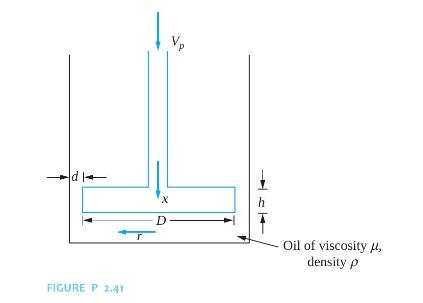Shock absorbers and many other forms of viscous dampers use a piston moving in a cylinder of
Question:
Shock absorbers and many other forms of viscous dampers use a piston moving in a cylinder of viscous liquid as illustrated in Figure P2.41. For this configuration the force developed on the piston is the sum of the viscous forces acting on the side of the piston and the force due to the pressure difference between the top and bottom surfaces of the piston.
(a) Assume the piston moves with a constant velocity \(v_{\text {p }}\). Draw a free-body diagram of the piston and mathematically relate the damping force, the viscous force, and the pressure force.
(b) Assume steady flow between the side of the piston and the side of the cylinder. Show that the equation governing the velocity profile between the piston and the cylinder is \(\frac{d p}{d x}=\mu \frac{\partial v^{2}}{\partial r^{2}}\)
(c) Assume the vertical pressure gradient is constant. Use the preceding results to determine the velocity profile in terms of the damping force and the shear stress on the side of the piston.
(d) Use the results of part (c) to determine the wall shear stress in terms of the damping force.
(e) Note that the flow rate between the piston and the cylinder is equal to the rate at which liquid is displaced by the piston. Use this information to determine the damping force in terms of the velocity and thus the damping coefficient.
(f) Use the results of part (e) to design a shock absorber for a motorcycle that uses SAE 1040 oil and requires a damping coefficient of \(1000 \mathrm{~N} \cdot \mathrm{m} / \mathrm{s}\).

Step by Step Answer:





